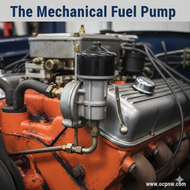In a world dominated by high-pressure injectors and sophisticated electronics, it's easy to overlook the humble mechanical fuel pump. But for millions of classic cars and trucks on the road today, this simple device is the absolute heartbeat of the engine. It's the silent, hardworking hero that gets the fuel where it needs to go, all without a single wire or circuit board.
So, what exactly is this marvel of engineering, and why does it still have a place in our hearts (and our garages)?
A Simple Job, Done Beautifully
The mechanical fuel pump has one purpose: to draw gasoline from the fuel tank and push it to the carburetor. Unlike modern electric pumps that hum away inside the tank, the mechanical version lives on the side of the engine, driven directly by the engine's rotation.
Its design is a testament to the "less is more" philosophy. Inside, you'll find a diaphragm, a few one-way check valves, and a rocker arm. As the engine's camshaft spins, a lobe on the shaft pushes against the rocker arm, which in turn moves the diaphragm. This action creates a vacuum, drawing fuel in from the tank. As the camshaft lobe passes, a spring pushes the diaphragm back, forcing the fuel out and into the line leading to the carburetor. It's a rhythmic, push-and-pull dance that perfectly supplies the engine with the fuel it needs.
Why We Still Love Them
-
Pure Simplicity: There are no complex electrical components to fail. No fuses to blow, no relays to go bad. As long as the engine is turning, the pump is working.
-
Self-Contained Power: The pump gets all the power it needs from the engine itself. This frees up the vehicle's electrical system for other vital functions like the ignition and lights.
-
Reliability: The robust, simple design means these pumps can last for decades. A little wear and tear on the diaphragm or rocker arm is typically all that eventually leads to a replacement.
Signs a Pump Is Getting Tired
While they're tough, they aren't immortal. The two main causes of failure are a worn-out diaphragm or a leaky seal. If your vintage vehicle is showing any of these symptoms, your fuel pump might be the culprit:
-
Hard Starting: The engine cranks but struggles to fire up, especially after sitting for a while.
-
Stalling or Stumbling: The engine might run fine at idle but stumbles or dies under load or at higher speeds as it's not getting enough fuel.
-
Visible Fuel Leaks: Any sign of gasoline leaking from the pump's housing is an immediate red flag and needs to be addressed for safety.
The mechanical fuel pump is more than just a component; it's a direct link to a time when engineering was about clever mechanical solutions. It's a reminder that sometimes, the simplest answer is the best. So next time you pop the hood, take a moment to appreciate the unsung hero that's been pumping away, keeping your classic running and on the road.

